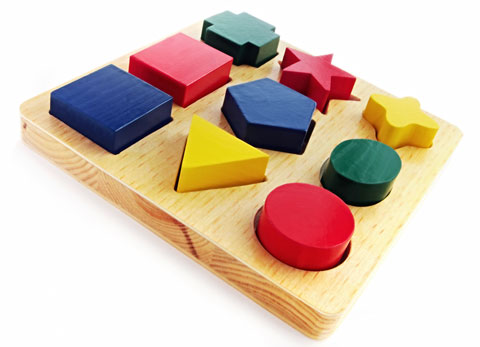Children ages 3–5 are beginning to learn about shapes, spaces, and locations—basic concepts of geometry. They use geometric thinking when they build with blocks, assemble a floor puzzle, or play a target game. Here are some ways to engage preschoolers with geometry.
Use the language of geometry.
- Describe objects by their shape when you talk with children. “You found a square piece of fabric.” “Kaya used two cylinder blocks in her tower.”
- Use words such as side, solid, surface, point, straight, curve, inside, flat, top, angle.
- Look at art work together and talk about how artists use lines and shapes. Help children recognize lines and shapes in their drawings.
- Help children ask and answer thought-provoking questions. “If Mario places these three rods next to each other, what shape will he have?” “How can you tell this is a circle and not a square?” “What could you do if you wanted to turn the square on the geoboard into a triangle?”
Make geometry a part of daily routines.
- Have children line up to go places. Ask them who is at the beginning or end of the line.
- Label shelves with the outlines of items that should go there. Children can put away toys and supplies by matching each item to its outline.
- Help older preschoolers make comparisons of shapes and sizes. “Will that paper rectangle fit inside this round basket?”
Plan activities involving shapes, spaces, and locations.
- Have children position their hands, feet, or bodies to make basic shapes. “Can you make a triangle using your hands?” “Can four of you lay on the ground and create a square?”
- Offer containers of various shapes (cubes, pyramids, etc.) for sand and water play.
- Encourage children to work together on puzzles, tangrams, and mazes.
- Invite children to draw or make 3-D representations of things they observe indoors and outdoors.
- Let children explore drawing aids such as rulers, protractors, French curves, and stencils.
- Provide building blocks, pattern blocks, geoboards, pegboards, straws, buttons, and beads for creating designs and structures. Teach children to weave, braid, and sew. Show them how to fold, cut, and arrange paper and other materials to make mosaics, collages, and other designs.
Play games that involve spaces, shapes, and locations.
- Introduce table games such as Carrom, Candy Land, tic-tac-toe, and card games such as Slapjack or Memory.
- Teach active games such as Fox and Geese, Mary Mack, Musical Chairs, beanbag toss, and variations on bowling.
IEL Resource
- Resource List: Math for Preschoolers


 PDF
PDF